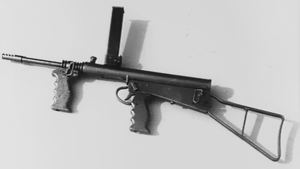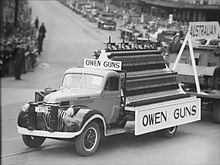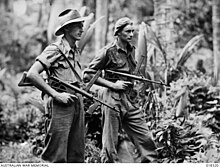Owen gun
This article needs additional citations for verification. (May 2013) |
| Owen gun | |
|---|---|
 The final design of the Owen machine carbine | |
| Type | Submachine gun |
| Place of origin | Australia |
| Service history | |
| In service | 1942–1960s |
| Used by | See Users |
| Wars | |
| Production history | |
| Designer | Lieutenant Evelyn Owen[1] |
| Designed | 1931–1939 |
| Manufacturer | Lysaght’s Works[1] |
| Produced | 1942–1944 |
| No. built | 45,000[1] |
| Specifications | |
| Mass | 4.23 kg (9.33 lb) without magazine[1] 4.86 kg (10.7 lb) loaded[1] |
| Length | 813 mm (32.0 in)[1] |
| Barrel length | 250 mm (9.84 in)[1] |
| Cartridge | 9×19mm Parabellum |
| Action | Blowback, open bolt |
| Rate of fire | 700 rounds/min[1] |
| Muzzle velocity | 366 m/s (1,200 ft/s)[1] |
| Effective firing range | 123 metres (135 yd) |
| Maximum firing range | 200 metres (220 yd)[1] |
| Feed system | 33-round detachable magazine |
| Sights | Iron sights |
The Owen gun, which was known officially as the Owen machine carbine, was an Australian submachine gun designed by Evelyn Owen in 1939. The Owen was the only entirely Australian-designed and constructed service submachine gun of World War II and was used by the Australian Army from 1943 until the mid-1960s.
History[]

Owen, an inventor from Wollongong, was 24 years old in July 1939 when he demonstrated his prototype .22 calibre "Machine Carbine" to Australian Army ordnance officers at Victoria Barracks in Sydney. The gun was rejected for two reasons. The first was because the Australian army, at the time, did not recognise the value of submachine guns. The second was the basic construction of the prototype was completely unsuited as a military weapon, especially as it lacked a proper trigger or any safety device, was of small calibre, and the "magazine" was effectively a giant revolver cylinder which could not be exchanged to reload. Following the outbreak of war, Owen joined the Australian Army as a private.
In September 1940, Owen's neighbour, Vincent Wardell, discovered Owen's prototype in a sugar bag. Wardell was manager of a large steel products factory at Port Kembla. He showed it to Owen's father who was distressed at his son's carelessness, but explained the history of the weapon. Wardell was impressed by the simplicity of Owen's design. Wardell arranged to have Owen transferred to the Army Inventions Board, to re-commence work on the gun. The army continued to view the weapon in a negative light, but the government took an increasingly favourable view.
The prototype was equipped with a "magazine" consisting of a steel ring, drilled with holes for .22 cartridges, that was revolved through the action using the power of a gramophone spring. This arrangement later gave way to a top-mounted box magazine, which allowed shooting while prone.
The choice of calibre took some time to be settled. As large quantities of Colt .45 ACP cartridges were available; it was decided to adopt the Owen gun for it. Official trials were organised, and the John Lysaght factory made three versions in 9×19mm, .38-200 and .45 ACP. Sten and Thompson submachine guns were used as benchmarks. As part of the testing, all of the guns were immersed in mud and covered with sand to simulate the harshest environments in which they would be used. The Owen was the only gun that still operated after the treatment. Although the test showed the Owen's capability, the army could not decide on a calibre, and it was only after intervention from the higher levels of government that the army ordered the 9×19mm variant.
During the gun's life, its reliability earned it the nickname "Digger's Darling" by Australian troops,[2] and it was rumoured to be highly favoured by US troops. General Douglas MacArthur proposed placing an order for some 45,000.[when?]
Production and use[]

The Owen went into production at the John Lysaght factories at Port Kembla and Newcastle. Between March 1942 and February 1943, Lysaght's produced 28,000 Owen guns. However, the initial batch of ammunition turned out to be the wrong type and 10,000 guns could not be supplied with ammunition. Once again the government overrode military bureaucracy, and took the ammunition through the final production stages and into the hands of Australian troops, at that time fighting Japanese forces in New Guinea. Approximately 45,000 Owens were produced from 1942 to 1944.[3] Contemporary sources vary as to the cost of production during wartime, with some suggesting that the basic cost was as little as A£8 (US$24); a contemporary US source stated that the Owen cost US$30 (A£12).[4]

Although it was somewhat bulky, the Owen became very popular with soldiers because of its reliability.[5] New Zealanders fighting in the Guadacanal and Solomon Islands campaigns swapped their Thompson submachine guns for Owens, as they found Owen guns to be more reliable.[6] Many of the Australian soldiers who had used the Owen came back to personally thank the Lysaght team as they believed the Owen had saved their lives.[7]
After World War II, the Dutch used the Owen during the Indonesian National Revolution. Some Owens were captured and used by the Indonesians.
The Owen was later used by Australian troops in the Korean and Vietnam Wars,[8] particularly the scouts in infantry sections. It remained a standard weapon of the Australian Army until the mid-1960s, when it was replaced by the F1 submachine gun and, later, the M16.[2]
Design[]

The Owen has a simple blowback design, firing from an open bolt. It was designed to be fired either from the shoulder or the hip. It is easily recognisable, owing to its unconventional appearance, including the top-mounted magazine, and the side-mounted sight required to allow the firer to aim past it. The placement of the magazine allows gravity to assist the magazine spring in pushing cartridges down to the breech, which improves feeding reliability. Another unusual feature is the separate compartment inside the receiver, which isolates the small-diameter bolt from its retracting handle by means of a small bulkhead. This prevents dirt and mud from jamming the bolt, and makes the Owen a highly reliable weapon. Foreign dirt entering the gun would collect at the back of the receiver, where it would drain out or be expelled through a small opening. When tested, the Owen gun was able to continue firing despite being dipped in mud and drenched with sand, while a Sten gun and a Thompson also tested stopped functioning at once. In jungle warfare, where both mud and sand were frequent problems, the Owen gun was highly regarded by the soldiers.[9]
To facilitate cleaning, the ejector was built into the magazine, rather than the body of the gun. This allowed the barrel to be removed rapidly, by pulling up a spring-loaded plunger in front of the magazine housing. After removing the barrel, the bolt and return spring are removed in a forward direction, completely dismantling the gun. Like the Sten, the Owen had a non-folding wire buttstock, but also had pistol grips like the Austen.[10]
Two horseshoe magazines were constructed in the field, of 60 and 72 rounds. Little information exists as to the success of these experiments.[11]
In 2004, an underground weapons factory was seized in Melbourne, Australia, yielding, among other things, three silenced copies of the Owen submachine gun and parts to make six more. These had magazines inserted underneath rather than overhead, and were suspected of having been built for sale to local gangs involved in the illegal drug trade.[12]
Users[]
 Australia[13]
Australia[13] Indonesia[14]
Indonesia[14] Laos[15]
Laos[15] Netherlands[16]
Netherlands[16] New Zealand[17]
New Zealand[17] Rhodesia[18][19]
Rhodesia[18][19] United Kingdom[20]
United Kingdom[20]
Engineering heritage award[]
The gun received an Engineering Heritage National Marker from Engineers Australia as part of its Engineering Heritage Recognition Program.[21]
References[]
- ^ Jump up to: a b c d e f g h i j Archer, Dennis (1977). Jane's Infantry Weapons 1977. p. 67. ISBN 978-0-354-00549-4.
- ^ Jump up to: a b "The 'Digger's Darling'". Queensland Government. Archived from the original on 27 October 2018. Retrieved 9 September 2018.
- ^ Bardwell, James O. (1995). "The Owen Gun". Machine Guns News (4).
- ^ "Submachine Gun Becomes Pistol by Detaching Butt." Popular Mechanics, November 1945, p. 75.
- ^ "A Year to Remember 1942". YouTube. Retrieved 21 March 2021.
- ^ Larsen, Colin R. (1946). "Chapter XII – Guadalcanal". Pacific Commandos: New Zealanders and Fijians in Action. A History of Southern Independent Commando and First Commando Fiji Guerrillas. Wellington: Reed Publishing. pp. 93–103.
- ^ Boleyn, Doug (January 2017). "Nomination of OWEN SUBMACHINE GUN for an Engineering Heritage National Marker" (PDF). Engineering Heritage Sydney. Retrieved 10 April 2021.
- ^ "Kokoda Track Tours – Home". Kokoda Historical. Retrieved 19 November 2012.
- ^ Barber, Graeme. "Owen and Austen – The WW 2 'Aussie' Machine Carbine Story". Mainland Arms. Retrieved 24 July 2014.
- ^ Forgotten Weapons. "The Diggers' Dismay: Austen Mk I SMG". YouTube.
- ^ "History of the Owen Machine Carbine (OMC)". diggerhistory.info. Archived from the original on 13 March 2011. Retrieved 19 November 2012.
- ^ Brendan Nicholson, Daniel Ziffer (23 July 2004). "Submachine-guns found in weapons factory". The Age. Melbourne.
- ^ McNab, Chris (2002). 20th Century Military Uniforms (2nd ed.). Kent: Grange Books. ISBN 978-1-84013-476-6.
- ^ "Australia's adversaries: Relations with Indonesia during the confrontation". anzacportal.dva.gov.au. Department of Veterans' Affairs. Archived from the original on 4 August 2017.
- ^ Kenneth Conboy and Simon McCouaig, The War in Laos 1960-75, Men-at-arms series 217, Osprey Publishing Ltd, London 1989, ISBN 9780850459388, p. 36.
- ^ Scarlata, Paul (20 April 2009). "Small Arms of the Koninlijk Nederlands-Indisch Leger, Part 2". Shotgun News.
- ^ "Owen submachine gun". collections.tepapa.govt.nz. Museum of New Zealand Te Papa Tongarewa.
- ^ "The Owen Gun". Nazarian's Gun Recognition Guide.
- ^ Diamond, Jon. "Australia's Owen Gun". Warfare History Network.
- ^ "The Malyan Emergency 1948-1960". iwm.org.uk.
- ^ "Overland Telegraph, Adelaide to Darwin, 1872-". Engineers Australia. Retrieved 7 May 2020.
Further reading[]
- The Owen gun, 1991, Wayne Wardman ISBN 978-0731603657
- The Owen gun files: An Australian wartime controversy, 1994, Kevin Smith ISBN 978-0908031542
External links[]
| Wikimedia Commons has media related to Owen gun. |
- World War II infantry weapons of Australia
- World War II submachine guns
- 9mm Parabellum submachine guns
- Recipients of Engineers Australia engineering heritage markers
